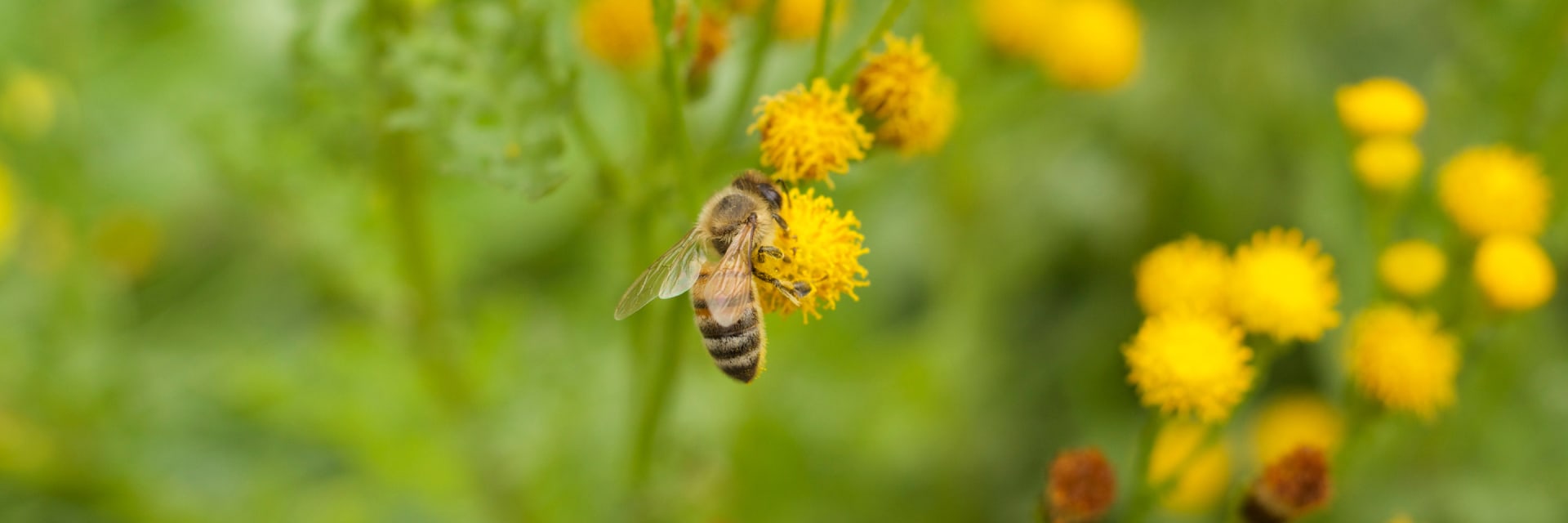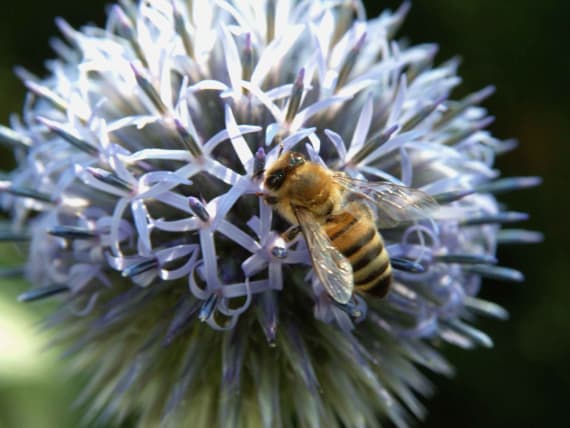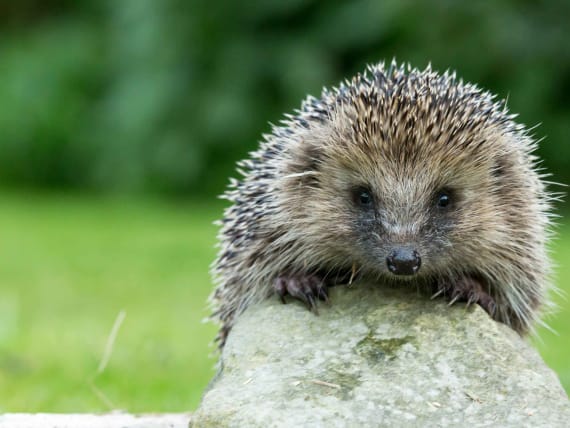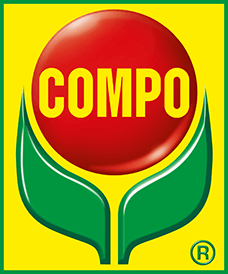Frequent search terms

- COMPO
- Guide
- Plant Care
- Basics
- Organic gardening
- Supporting bees and other beneficial insects in your garden
Supporting bees and other beneficial insects in your garden
Not only can your garden offer a home to plants, beneficial insects will also flourish there. Help wild bees and bumble bees, toads and lizards, mammals like hedgehogs, martens and weasels as well as birds to find a nice shelter in your garden. We show you how you can help beneficial insects.

Why wild bees are so important in our ecosystem
There are more than 500 bee species in Central Europe. A distinction is made between honey bees, leaf-cutting bees, sand bees, plasterer bees, furrow bees, blunt-horned mining bees and hairy-footed flower bees. With the exception of the honey bee, all bee species are referred to as wild bees.
As well as honey bees, wild bees pollinate plants. If there are no beehives nearby, wild bees and bumble bees take over the pollination of our garden plants, such as berry bushes, apple trees or sunflowers.
Most wild bees live alone. They build themselves tubular nests in tall stems or rotten wood and plant materials. But they are also happy with holes in walls.
Wild bees like it warm. So, they are drawn in by houses due to their heat emissions. They are not afraid of people. They are wonderful to observe because they have no aggressive tendencies.
Unfortunately, they are considered endangered insects. Their population has declined rapidly over the last 20 to 30 years. The reason for this is that they can't find enough food, and their breeding grounds and hibernating spots are just as scarce.
Facilitating the right plant varieties for wild bees
The following plants are used to build nests and facilitate the settlement of bees:
- Balcony and garden plants: wild rose, cotoneaster, pasture, fruit trees, currant, gooseberry, raspberry, blackberry, vetch, marigold.
- Plants suitable for humid locations: buttercup, purple loosestrife, sulphur cinquefoil
- Plants for dry, pebbly locations: creeping cinquefoil, Echium, bindweed, creeping bellflower
- Plants for dry and sunny locations (poor grassland): Veronica teucrium, bellflower, cinquefoil
Some wild bees specialise in certain food crops and cannot switch to other flowering plants to sustain themselves. Supporting biotopes helps different vegetation to grow, which acts as a source of nutrition for bees.
Simple tips and tricks
How you can help the beneficial insects in your garden
Plant pollinators
Wild bees

You can do the following to encourage the settlement of wild bees in your own garden:
• Put up nesting aids for wild bees
• Facilitate plant varieties that make suitable nest building material for wild bees
• Plant food crops in the nesting area
There are many different species of wild bee. Different species prefer different nesting aids. Create a home for beneficial insects with the following measures:
Nesting aids for inhabitants of rotten wood
Some wild bees build their nest in rotten wood. If you have rotten wood, snags or pieces of wood in your garden, these species will be attracted. Woodpiles are also very alluring to wild bees. So, it is better to not throw away rotten wood, instead stack it in a protected place in your garden.
Nesting aids for inhabitants of hollow spaces
These wild bees nest in tall stems, knot holes and twigs. Saw off 1 to 1.5 cm thick bamboo canes after the thickening to build your bee hotel. This way, you will have many tubes that you can put in a tin, for example. To protect the bamboo tubes against wind and rain, an overhang made from roofing felt is attached to the tin. Besides bamboo tubes, the hollow shoots of forsythia, reeds or elder are also suitable. Blocks of oak and ash wood are also very well received. Drill through the blocks with a drill of different drilling sizes (2 to 8 mm) and place them in a sheltered location.
Nesting aids for inhabitants of myelinated pithy stems
Mullein, raspberry, blackberry and wild rose have myelinated stems. These plants can be pruned with shears so that bees can get into the medulla. It is also possible to attach the pruned shoots to a garden fence in a vertical position.
Pest eaters
Lizards

Interesting facts about lizards
Lizards are considered to be beneficial insects. They feed off lice, cicadas, ants, flies, grasshoppers, spiders and centipedes. If you want to make a home for lizards in your garden, you have good chances of keeping your garden free from pests.
Some lizards are endangered species. Their habitats are increasingly being replaced in organised gardens and landscapes. The lawnmower is the enemy of lizards. Lawns are mowed too short or the animals are injured by the mowing. Pets, such as cats, also hunt lizards.
Lizards are cold-blooded animals. This means that they feel at home in sunny spots that are undisturbed. The timid animals also need plenty of hiding places and, most importantly, frost-free places to spend the winter.
Create quiet, sunny spots
Lizards look for warm stones to keep them warm. So it is a good idea to make piles of stones. The stones should be flat and vary in size. They should be combined with sand or gravel. A spot that is as isolated as possible is chosen as a location for the timid animals. If the area is too shaded, you can prune the surrounding shrubs. Allow some open spaces in gardens with lots of trees. Lizards feel right at home in clearings.
Provide places of refuge
Use woodpiles made up of various sized branches and root pieces in protected places to make places of refuge. Keep in mind that these layers gradually decompose. Regularly add more material to the pile. Grassy areas near paths and ditches should only be mowed on occasion. Long grass should be left in the border area as it acts as a place of refuge for the animals.
Create egg-laying spots
Heap up cuttings, manure, foliage and branches, ideally close to the edge of forests or near water. The piles should be in semi-shaded spots. As lizards like to settle in piles of cuttings, these should be restacked before they are burned. Otherwise the animals could die in the fire.
Garden helper
Hedgehogs

Interesting facts about hedgehogs
Hedgehogs are mammals. The most common species in Europe is the European hedgehog. As insectivores, they are a great help in the garden. They are nocturnal and wander through beds with a big appetite. They primarily feed on insects, larvae and ring worms. Snails are their favourite food.
Hedgehogs prefer dry habitats. They can be found in clear woodlands, grasslands and gardens. They usually dig their own burrows that they use as resting places. They hibernate in cooler places.
How you can help hedgehogs
Although the hedgehog is a wild animal, it increasingly seeks out its habitats close to humans. Hedgehogs will feel at home if your garden offers an adequate food supply and places to shelter.
Compost heaps are the perfect source of nutrition and refuges for hedgehogs. It should be ensured that hedgehogs can reach the compost heap. Open compost heaps with no borders are optimal. Alternatively, a heap of foliage and cuttings from trees, shrubs and lawns can be made in a protected place in your garden.
If you are accommodating a hedgehog in your garden, you should avoid burning garden waste as far as possible. However, if this is necessary, the garden waste should be restacked beforehand to ensure that the hedgehog is not in it.
On the mouse hunt
Birds of prey

Birds of prey keep our surroundings free from mice and other rodents. It is helpful to set up perches in your garden to make hunting easier for them. Owls and birds of prey need to save energy in the winter. Circling while searching for prey saps their energy. So, they rely on perches more heavily during the cold months.
The following applies to the perch: The taller it is, the larger the area of visibility of the bird of prey. The structure should therefore be at least two metres tall. It is important that the pole is anchored firmly into the ground and doesn't wobble. Wood is a suitable material for this. If you have a longer metal pole, this can also work well.
If possible, do not knock the pole into the ground with a hammer or heavy equipment. This can cause the wood to split. It is best to dig a hole of 40 or 50 cm and place the pole in it. Then the hole is filled up again so that the pole stands firmly in the ground. The lower part of the perch should be sealed with a wood preservative.
A crossbeam is mounted on the top of the pole. It should be coarse so that it is non-slip for the birds. The length should be at least 20 cm and the diameter 3 to 5 cm. An angle iron can support the crossbar as needed.


